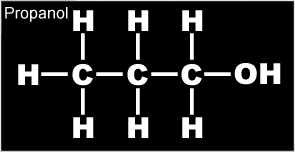|
Carbon is an element upon which all life depends and with which all animal and vegetable matter is made of. It is one of the most widely distributed elements in nature, occuring practically everywhere except in water. It occurs in the atmosphere as CO2
(carbon dioxide), in metal carbonates in rocks (for example limestone), in fossil fuels in the earth (coal, oil, gas, peat) and as pure carbon such as diamond and graphite.
"Carbon exists in several different forms called allotropes. These can be described as different physical forms of the same element due to different arrangement of carbon atoms",
just like a toddler, a teenager and an adult are all versions of a human being.
Organic Chemistry
Carbon is distinct among the elements in that it forms well over 2 million compounds which is four times that of the compounds of all the other elements put together! Therefore the chemistry of
carbon is a separate branch of chemistry called Organic Chemistry. This large number of compounds is divided into two classes of compounds: aliphatics and aromatics. The aliphatic class consists
of carbon compounds formed from chains of carbon atoms while the aromatics consist of carbon compounds made of rings of carbons.
Focusing on aliphatics, this series can be further divided into families called homologous series of compounds.
A homologous series is a group of compounds which contain the same functional group of atoms and sucessive members differ in size by a CH2 group.
The functional group is the part of the compound that reacts with another compound. Sort of like a rock group. The group interacts with the audience but there is also other groups behind the
stage that make such an interaction possible.
Here is propanol...

A question. Can you say if it's an aliphatic or aromatic compound?
The COH group is the functional group of this compound and all the other members of the series. This is the part that does
the singing and dancing, guys! Groovy, Baby! Propanol, when it's at home, is a suitable solvent for organic substances.
An introduction to Propanol's buddies (or groupies) is in order now;
 Methanol, which has one carbon atom linked Methanol, which has one carbon atom linked
 Ethanol, two carbon atoms linked Ethanol, two carbon atoms linked
 Butanol, four carbon atoms linked Butanol, four carbon atoms linked
 Pentanol, five carbon atoms linked Pentanol, five carbon atoms linked
the series continues.
Propanol and it's buddies are referred to as ALCOHOLS. Yep. "This bud's for you" and "Live life to the power of Guinness" are just alias's for aliphatic organic compounds that have 2 carbon atoms linked together.
In addition to the alcohols, the other groups in the aliphatic series are:
| Compound | Example |
| Alkanes | Ethane |
| Alkenes | Ethene |
| Alkynes | Ethyne |
| Aldehydes | Ethanal |
| Ketones | Propanone |
| Carboxylic acids | Propanoic acid |
| Esters | Ethyl ethanoate |
Ethanal is a member of the Aldehyde group of Carbon compounds. It contains 2 carbon atoms and 4 hydogen atoms in it's molecule. A single Oxygen atom joined by a double bond to a Carbon atom accompanied by a single Hydrogen identifies this group.
Propanal is a member of the Aldehyde group of Carbon compunds whose molecule contains 3 Carbon atoms, 6 Hydrogens and a single Oxygen.
Ethanoic Acid is a member of the Carboxylic acids group of Carbon compounds. It contains 2 carbons in it's molecule, one of which is joined to a lone Oxygen in a double bond and a Hydroxide group (OH).
Propanoic Acid is a member of the Carboxylic acids group of Carbon compounds. It contains 3 Carbons in it's molecule, one of which is attached to a lone Oxygen in a double bond and a Hydroxide group (OH).
Ethane is a member of the Alkane family of organic compounds. It is a compound containing 2 Carbon atoms and 6 Hydrogen atoms. All atoms are attached via a single bond.
Propane is a member of the Alkane family of Organic compounds. It is a compound whose molecule contains 3 Carbon atoms and 8 Hydrogen atoms and 8 Hydrogen atoms all of which are joined by a single bond.
Ethanol is a member of the Alcohol family of the organic compounds. It is a Carbon compound whose molecule contains 2 Carbon atoms, one of which is attached to an Hydroxide group (OH).
Propan-1-OL is a member of the Alcohol family of organic compounds. It's molecule however contains 3 Carbon atoms. The first of which is bonded to a Hydroxide group (Hence 1-OL)

|












